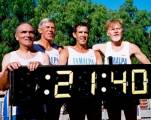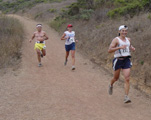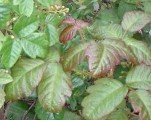




by Janet F. Bowman
Join any conversation among Tamalpa members between January and June, and sooner or later you will hear the word "Dipsea". They're talking about the Dipsea Race, a Tamalpa focal point, a fixation, or, in many cases, an obsession.
The Dipsea Race is to Marin what the Super Bowl is to the United States. It's our premier athletic competition, steeped in nearly a century's worth of racing lore and bragging rights. Today it's the nation's second oldest major footrace, dating from 1905 (only the Boston Marathon is older.) Held each year on the second Sunday in June, the Dipsea is a 7.1 mile point-to-point race from downtown Mill Valley to the sands of Stinson Beach, over a course that ascends (and descends) two major hills with a total elevation gain of 2000 feet. The course is narrow, rutted, and steep. It's often overgrown, and loose rocks, roots, and slippery footing contribute to a significant risk of injury. Of course, those same factors contribute to the challenge and appeal.
There are other unique aspects of the Dipsea Race. For one, the course is "open". This means, in theory, that any route is acceptable as long as an entrant starts at the start and finishes at the finish. In other words, "shortcuts" are legal. In practice, though, the course has been so thoroughly analyzed over its long history that the shortest route is marked and known to all. The main alternatives exist in a few spots where a slightly shorter but steeper and more dangerous trail parallels a slightly longer alternative with better footing. The number of such spots has been sharply reduced in recent years by park service regulations designed to keep runners on a single trail, to minimize erosion and unnecessary human presence in wild areas. As a result, most of the best shortcuts of yesteryear are no longer legal, and most runners follow the same, consensus route.
Another distinguishing Dipsea characteristic is the handicapping system, which dates from the Dipsea's earliest days. Originally, handicaps (headstart minutes) were assigned by the race directors based on their subjective opinions of each entrant's ability. The goal was to make it possible for anyone to win, as long as he (the race was then all male) fully realized his potential with a maximal performance. Beginning in 1965, individual handicaps were replaced by handicaps assigned by age, with the very old and very young getting the biggest headstarts over the "scratch" runners -- those in their 20's to mid-30's, considered the prime running years.
In the 1960's, women occasionally ran the Dipsea, but they were not officially recognized as contestants until 1971. At that time, the handicapping concept was extended to take gender as well as age into account, and two years later the Dipsea had its first female winner, 10 year old Mary Etta Boitano.
Today the Dipsea handicaps are necessary not only to make it possible for excellent runners of any age or sex to have a chance at crossing the finish line first, but also to control crowding. The trail is far too narrow to accommodate the 1500 runners accepted each year if all were to start at once, so a staggered start is vital. Initially, the handicaps were crude and subject to every kind of complaint and accusation of unfairness. Since that time, they have been refined year by year in response to actual Dipsea course records at every age level. The modern Dipsea is run in two heats, "Invitational" and "Runner", with each heat divided into 24 groups starting exactly one minute apart, with the scratch runners always starting last.
Tamalpans have played a major role in the Dipsea ever since the club's inception late in 1976. Tamalpa won the team title in its first year of Dipsea competition, 1977, and has repeated every single year without exception, right up to the present. Many Tamalpans have been winners, including Don Pickett (1968), Darryl Beardall ('74 and '78), Don Chaffee ('79), Donna Andrews ('80), Florianne Harp ('81), Christie Patterson ('87), Kay Willoughby ('88), Eve Pell ('89), Shirley Matson ('93, '00, '01 and '04), Russ Kiernan ('98, '02 and '05), and Melody-Anne Schultz ('99 and '03). Yet for the rank-and-file Tamalpan, the Dipsea is no less important. Competition is keen not just to win, but to finish in the Top 35 and receive a coveted numbered "Black Shirt" at the awards ceremony; to finish in the Top 100 and get your finishing place as your race number the following year; or to qualify for next year's Invitational section by finishing in the Top 450 (or beat the equivalent time if in the Runner section.) For Tamalpans, the Dipsea is the single most popular and talked-about event of the year, with over 300 club members racing and still more volunteering, and all reuniting in joyful celebration at the post-race picnic.
Admission to the Dipsea is tight, with about 1000 more applications received each year than can be accepted. If you're a first-timer, submitting your app early is crucial. Get on the mailing list by sending a written request no later than March 1 to : Dipsea Race, P.O. Box 30, Mill Valley, CA 94942. Race applications are mailed out on March 15. For more information, you may also call the Dipsea hotline at (415) 331-3550, or log onto the Dipsea web site at www.dipsea.org. You can also e-mail the race directors at dipseainfo@dipsea.org.
Some Dipsea highlights:
Tamalpa Gazettes
July 2016 Gazette
Older Issues
The Most Useful Links
Kees Training Blog
Frank's "Tamalpa This & That"
Tamalpa Talks
Five Most Recent posts from the Tamalpa Forum